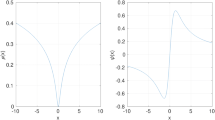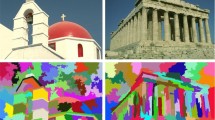Abstract
In complex color images, colors inside a homogeneous region might be contradistinctive and the distribution could not be described by a simple Gaussian distribution as used in traditional image segmentation algorithms. Based on the characteristics that the red, green, and blue color planes are not independent and pixels in the same neighborhood system might stand for the same object, we introduce a Gaussian model containing the interactions between different color planes to strengthen the connections both on a color plane and between color planes in a neighborhood system. Consequently, a Gaussian mixture model with the prior distribution, defined by Markov random field and acting as the weight, is employed to describe the distribution of color measures inside a homogeneous region. With the Gaussian mixture model containing the interactions between color planes, we proposed a fuzzy clustering approach for complex color image segmentation. Experiments on synthetic and real-color images, in which homogeneous regions are complex, show that the proposed algorithm compares favorably with the compared algorithms developed for the same purpose.





Similar content being viewed by others
Explore related subjects
Discover the latest articles, news and stories from top researchers in related subjects.References
Cha, S., Mccleary, K.W., Uysal, M.: Travel motivations of Japanese overseas travelers: a factor-cluster segmentation approach. J. Travel Res. 34(1), 33–39 (1995)
Kothari, S., Chaudry, Q., Wang, M.D.: Automated cell counting and cluster segmentation using concavity detection and ellipse fitting techniques. In: Proceedings of IEEE International Symposium on Biomedical Imaging: From Nano to Macro, pp. 795–798. Boston, MA (2009)
Djokic, N., Salai, S., Kovac-Znidersic, R., Djokic, I., Tomic, G.: The use of conjoint and cluster analysis for preference-based market segmentation. Inzinerine Ekonomika-Eng. Econ. 24(4), 343–355 (2013)
Sammouda, R., Youssef, B.B.: A comparison of cluster distance metrics for the segmentation of sputum color image using unsupervised Hopfield neural network classifier. In: 2014 Global Summit on Computer and Information Technology, Sousse, pp. 1–6 (2014)
Kim, Y., Kang, M., Kim, J.M.: Exploration of optimal many-core models for efficient image segmentation. IEEE Trans. Image Process. 22(5), 1767–1777 (2013)
Tan, K.S., Lim, W.H., Isa, N.A.M.: Novel initialization scheme for fuzzy c-means algorithm on color image segmentation. Appl. Soft Comput. 13(4), 1832–1852 (2013)
Zhao, F., Fan, J.L., Liu, H.Q.: Optimal-selection-based suppressed fuzzy c-means clustering algorithm with self-tuning non local spatial information for image segmentation. Expert Syst. 41(9), 4083–4093 (2014)
Preetha, R., Suresh, G.R.: Performance analysis of fuzzy c-means algorithm in automated detection of brain tumor. In: Proceedings of Congress on Computer Communication, pp. 30–33 (2014)
Krishna, K., Murty, M.N.: Genetic K-means algorithm. IEEE Trans. Syst. Man Cybern. Part B: Cybern. 29(3), 433–439 (1999)
Wagstaff, K., Cardie, C., Rogers S., Schroedl, S.: Constrained K-means clustering with background knowledge. In: Proceedings of the Eighteenth International Conference on Machine Learning, pp. 577–584 (2001)
Jain, A.K.: Data clustering: 50 years beyond K-means. Pattern Recogn. Lett. 31(8), 651–666 (2010)
Miyamoto, S., Mukaidono, M.: Fuzzy c-means as a regularization and maximum entropy approach. In: Proceedings of the 7th IFSA Congress, vol. 2, pp. 86–92 (1997)
Ichihashi, H., Miyagishi, K., Honda, K.: Fuzzy c-means clustering with regularization by K-L information. In: Proceedings of the 10th IEEE International Conference on Fuzzy System, vol. 2, pp. 924–927 (2001)
Miyamoto, S., Honda, K., Ichihashi, H.: Algorithms for Fuzzy Clustering Methods in C-Means Clustering with Applications. Springer, Berlin (2008)
Ahmed, M., Yamany, S., Mohamed, N., Farag, A., Moriarty, T.: A modified fuzzy C-means algorithm for bias field estimation and segmentation of MRI data. IEEE Trans. Med. Imag. 21(3), 193–199 (2002)
Chen, S., Zhang, D.: Robust image segmentation using FCM with spatial constraints based on new kernel-induced distance measure. IEEE Trans. Syst. Man Cybern. 34, 1907–1916 (2004)
Szilagyi, L., Benyo, Z., Szilagyii, S., Adam, H.: MR brain image segmentation using an enhanced fuzzy C-means algorithm. In: Proceedings of the 25th Anne International Conference of IEEE EMBS, pp. 17–21 (2003)
Cai, W., Chen, S., Zhang, D.: Fast and robust fuzzy c-means clustering algorithms incorporating local information for image segmentation algorithms incorporating local information for image segmentation. Pattern Recognit. 40(3), 825–838 (2007)
Krinidis, S., Chatzis, V.: A robust fuzzy local information c-means clustering algorithm. IEEE Trans. Image Process. 19(5), 1328–1337 (2010)
Chatzis, S.P., Varvarigou, T.A.: A fuzzy clustering approach toward hidden Markov random field models for enhanced spatially constrained image segmentation. IEEE Trans. Fuzzy Syst. 16(5), 1351–1361 (2008)
Panjwani, D.K., Healey, G.: Markov random field models for unsupervised segmentation of textured color image. IEEE Trans. Pattern Anal. Mach. Intell. 17(10), 939–954 (1995)
Rangarajan, A., Chellappa, R.: Markov random field models in image processing. In: Arbib, M. (ed.) The Handbook of Brain Theory and Neural Networks, pp. 564–567. MIT Press, Cambridge (1998)
Cesmeli, E., Wang, D.L.: Texture segmentation using Gaussian-Markov random fields and neural oscillator networks. IEEE Trans. Neural Netw. 12(2), 394–404 (2001)
Wang, W., Wainwright, M. J., Ramchandran, K.: Information-theoretic bounds on model selection for Gaussian Markov random fields. In: Proceedings of IEEE International Symposium on Information Theory, pp. 1373–1377. Austin, TX (2010)
Bolin, D., Wallin, J., Lindgren, F.: Multivariate latent Gaussian random field mixture models. Department of Mathematical Sciences, Division of Mathematical Statistics, Chalmers University of Technology and University of Gohenburg (2014)
Bezdek, J.: Pattern Recognition with Fuzzy Objective Function Algorithms. Plenum, New York (1981)
Zhang, J.: The mean field theory in EM procedures for Markov random fields. IEEE Trans. Signal Process. 40(10), 2570–2583 (1992)
Miyamoto, S., Honda, K., Ichihashi, H.: Algorithms for Fuzzy Clustering Methods in C-Means Clustering with Applications. Springer, Berlin (2008)
Acknowledgements
This work was supported by the National Natural Science Foundation of China [No. 41271435; No. 41301479].
Author information
Authors and Affiliations
Corresponding author
Appendix
Appendix
To obtain the derivation of the fuzzy membership u ij , we should minimize the objective function J m in Eq. (12) over it under the constraint
Introducing a Lagrange multiplier to the objective function, we have
Differentiating L with respect to u ij leads to
u ij is solved from Eq. (20) as
Since u ij satisfies Eq. (18), substitute Eq. (21) in to Eq. (18), the expression of u ij is obtained
To obtain the estimates of μ j , we need to conduct the minimization of J m in Eq. (12) over it
For 8-Neighborhood system, we have its expression as follows
Derivate J m over ∑ (−1) j , we can get
The expression of ∑ j is
The third term of Eq. (15) for d ij can be rewritten as
The derivation J m over α j is
Let Eq. (28) be equal to 0, we can solve α j as
Rights and permissions
About this article
Cite this article
Zhao, X., Li, Y. & Zhao, Q. A Fuzzy Clustering Approach for Complex Color Image Segmentation Based on Gaussian Model with Interactions between Color Planes and Mixture Gaussian Model. Int. J. Fuzzy Syst. 20, 309–317 (2018). https://doi.org/10.1007/s40815-017-0411-1
Received:
Revised:
Accepted:
Published:
Issue Date:
DOI: https://doi.org/10.1007/s40815-017-0411-1




